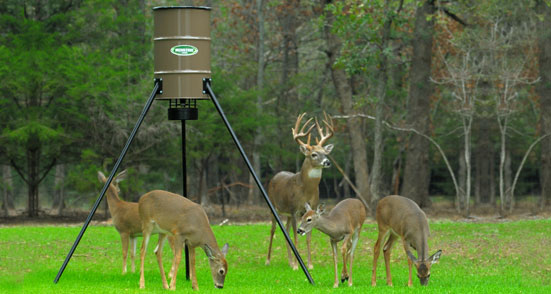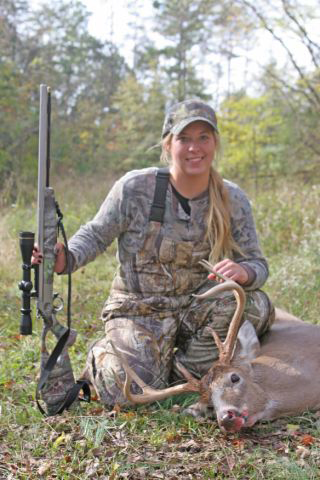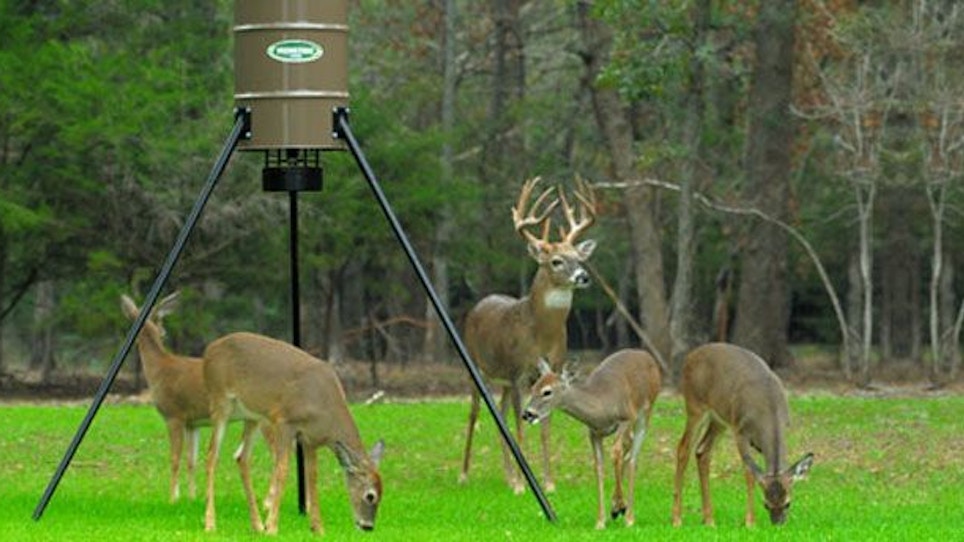 Hardcore deer hunters are pretty serious about their management efforts these days. They plant food plots, shoot only a certain number and age of deer, and otherwise pay close attention to the overall health of their deer herd. Sometimes though, that’s not enough.
Hardcore deer hunters are pretty serious about their management efforts these days. They plant food plots, shoot only a certain number and age of deer, and otherwise pay close attention to the overall health of their deer herd. Sometimes though, that’s not enough.
Drought, poor soil, or inadequate habitat are just a few reasons a deer herd doesn’t reach its full potential. No one can end a drought, of course, and it’s unrealistic to fertilize and lime an entire farm or forest. Food plots can give deer something to eat when little else is available, but even they are prone to the whims of Mother Nature.
That’s why many deer hunters are turning to supplemental feeding. It provides vital nutrition during the summer when growing antlers are most affected by the nutrition level in the deer’s food. A supplemental food source is also beneficial during the late winter when natural foods are sparse. Feeding deer high-quality food in the winter helps them go into spring in better shape.
Supplemental feeding is different than baiting, which is meant to draw deer to a particular location during hunting season. Feeding, on the other hand, can be done during hunting season or outside the season. Its primary purpose is to provide high-quality nutrition when it’s needed most and isn’t otherwise available.
The Right Stuff
So what do you put in your Moultrie feeder? Many hunters rely on corn. Deer absolutely love it. Corn, however, isn’t a good source of protein, a vital ingredient in antler growth and for nursing fawns. Corn is loaded with carbohydrates, a necessary dietary ingredient in the winter, but with just 7 to 10 percent protein, it doesn’t give whitetails what they need to grow big antlers or produce healthy fawns in the spring and summer.
That’s why knowledgeable deer managers rely on protein feed. A number of manufacturers make deer-specific pellets that work in both automatic and gravity-fed wild game feeders. It’s high in protein, 16 percent or more, and offers other vital nutrients that help grow bigger antlers and healthier fawns. Other pelleted feed can be an adequate substitute if deer pellets aren’t available, but make sure it contains at least 16 percent protein.
 Feed Right
Feed Right
No matter what you use, don’t pour it on the ground. That not only feeds whitetails, it keeps your local raccoon, squirrel, and crow populations fat and happy, costing you lots of money. Dropping pellets or corn on the ground can lead to disease, as well. When corn or feed gets wet, it can get mold, which, in turn, can harbor disease. Besides, deer tend to ignore soggy pellets.
That’s why dedicated deer managers rely on professional feeders. Some are gravity-fed, providing a constant supply of pellets or corn. Moultrie’s 55-gallon Protein Tripod Feeder, for instance, has three tubes that allow deer to eat when they want. The feed falls from the hopper through the tubes and is constantly replenished. Even better, the tubes are far enough off the ground that they can’t be raided by raccoons or pigs, which can put a sizeable dent in any feed budget.
An automatic feeder, also called a timed feeder, spreads corn or pellets at intervals set by the user. They can be programmed to start whenever you want and for as many times a day as you like. They can even be set to run for a specific amount of time. How often or how long you run your feeder depends on a variety of factors including your total deer population and your long-term goals. An automatic food feeder such as Moultrie’s 30-gallon Pro-Lock Feeder can provide ample nutrition without wasting costly feed.
Realistic Expectations
Make sure you have attainable goals. Studies have shown that using a deer feeder can produce healthier herds, but a number of factors play into the health of deer. The best results take place in controlled environments where deer are fed highly regulated diets designed for maximum results. It’s far tougher to control or manipulate the diets of wild deer, which will ignore even the most nutritious feed in favor of natural forage. That’s okay, though. Whitetails know what they need and when they need it. Plenty of native and natural foods are high in protein, and deer sometimes favor “real” food over manufactured feed. When those wild foods vanish, deer will come back to your feeders.
Even if bucks regularly visit your wildlife feeder, don’t expect to see a huge jump in antler sizes. Research has shown that protein feed can increase overall antler size, but the differences may be only a few inches in wild whitetail populations. A few inches, however, can mean the difference between a good buck and a great buck.






